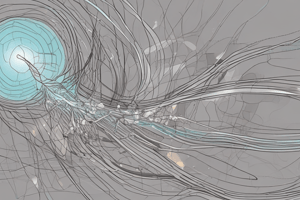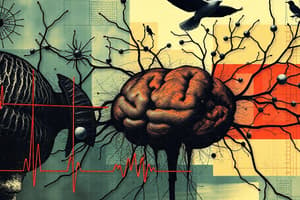Podcast
Questions and Answers
During depolarization, what change occurs in the membrane potential relative to the resting potential?
During depolarization, what change occurs in the membrane potential relative to the resting potential?
- It increases above the threshold potential.
- It increases above the resting potential. (correct)
- It decreases below the resting potential.
- It decreases below the threshold potential.
In a resting neuron, how does the intracellular environment differ from the extracellular environment in terms of charge and ion concentration?
In a resting neuron, how does the intracellular environment differ from the extracellular environment in terms of charge and ion concentration?
- The interior is more positively charged and has a lower concentration of sodium.
- The interior is more negatively charged and has a higher concentration of potassium. (correct)
- The interior is more positively charged and has a higher concentration of sodium.
- The interior is more negatively charged and has a higher concentration of sodium.
What term describes a change in membrane potential that makes it more negative than the resting potential (e.g., from -80mV to -120mV)?
What term describes a change in membrane potential that makes it more negative than the resting potential (e.g., from -80mV to -120mV)?
- Action potential
- Hyperpolarization (correct)
- Polarization
- Hypopolarization
How does Novocain, a local anesthetic that blocks voltage-gated $Na^+$ channels, cause numbness?
How does Novocain, a local anesthetic that blocks voltage-gated $Na^+$ channels, cause numbness?
What is the primary role of the refractory period in neurons?
What is the primary role of the refractory period in neurons?
Which of the following ionic events would MOST directly cause repolarization of a neuronal cell membrane?
Which of the following ionic events would MOST directly cause repolarization of a neuronal cell membrane?
Which statement is NOT correct when comparing local potentials and action potentials?
Which statement is NOT correct when comparing local potentials and action potentials?
Which sequence of ion movement correctly describes the rising and falling phases of an action potential?
Which sequence of ion movement correctly describes the rising and falling phases of an action potential?
In what type of axon would the slowest speed of action potential conduction be observed?
In what type of axon would the slowest speed of action potential conduction be observed?
When a chemical stimulus binds to receptors on a dendrite, which of the following is MOST likely to occur?
When a chemical stimulus binds to receptors on a dendrite, which of the following is MOST likely to occur?
How does saltatory conduction increase the speed of nerve impulse transmission?
How does saltatory conduction increase the speed of nerve impulse transmission?
A nurse pricks your finger to test your blood type, and you flinch. Which of the following BEST describes the pathway of nerve impulses in this reflex action?
A nurse pricks your finger to test your blood type, and you flinch. Which of the following BEST describes the pathway of nerve impulses in this reflex action?
If a neuron is at its resting membrane potential with a threshold of -55mV, what effect will a graded potential of -60mV have?
If a neuron is at its resting membrane potential with a threshold of -55mV, what effect will a graded potential of -60mV have?
Which type of nerve carries stretch receptor information from the stomach to the CNS?
Which type of nerve carries stretch receptor information from the stomach to the CNS?
Which type of nerve transmits impulses that cause pupil dilation?
Which type of nerve transmits impulses that cause pupil dilation?
Which type of nerve is responsible for increasing heart rate?
Which type of nerve is responsible for increasing heart rate?
Which nerve type transmits from the optic nerve to brain?
Which nerve type transmits from the optic nerve to brain?
Which nerve type transmits nerve impulses to the quadriceps?
Which nerve type transmits nerve impulses to the quadriceps?
Where do local potentials typically develop in a neuron?
Where do local potentials typically develop in a neuron?
In a neuron, which structure receives impulses, and where is the action potential triggered?
In a neuron, which structure receives impulses, and where is the action potential triggered?
Flashcards
What is Depolarization?
What is Depolarization?
Membrane potential becomes less negative, moving closer to zero.
Resting neuron's interior
Resting neuron's interior
The interior of a resting neuron is more negatively charged and has a higher concentration of potassium (K+).
What is Hyperpolarization?
What is Hyperpolarization?
A change in membrane potential that makes it more negative than resting potential.
Why does Novocain cause numbness?
Why does Novocain cause numbness?
Signup and view all the flashcards
Refractory period function
Refractory period function
Signup and view all the flashcards
Repolarization cause
Repolarization cause
Signup and view all the flashcards
Action potential size
Action potential size
Signup and view all the flashcards
Rising and falling phases
Rising and falling phases
Signup and view all the flashcards
Slowest action potential speed
Slowest action potential speed
Signup and view all the flashcards
Location of local potentials
Location of local potentials
Signup and view all the flashcards
Where action potentials are triggered
Where action potentials are triggered
Signup and view all the flashcards
Sodium channel binding
Sodium channel binding
Signup and view all the flashcards
Apparent jump
Apparent jump
Signup and view all the flashcards
Nerve impulse pathway
Nerve impulse pathway
Signup and view all the flashcards
Action potential graded
Action potential graded
Signup and view all the flashcards
Stomach nerves
Stomach nerves
Signup and view all the flashcards
Pupil impulses nerve
Pupil impulses nerve
Signup and view all the flashcards
Impulses that travel down
Impulses that travel down
Signup and view all the flashcards
Optic nerve
Optic nerve
Signup and view all the flashcards
What is the nerve to the leg quadriceps
What is the nerve to the leg quadriceps
Signup and view all the flashcards
Study Notes
- Depolarization results in the membrane potential increasing above the resting potential.
- The interior of a resting neuron is more negatively charged and has a higher concentration of sodium than the extracellular fluid.
- Hyperpolarization is any change in membrane potential that results in a value more negative than the resting potential (e.g., from -80mV to -120mV).
- Novocain blocks voltage-gated Na+ channels and prevents action potentials, leading to numbness.
- The refractory period ensures that an action potential only travels in one direction.
- The refractory period also has an "absolute" time, during which nothing can cause the channel to open again.
- Opening voltage-gated potassium channels causes repolarization of a neuronal cell membrane.
- All of the statements about local and action potentials are correct except action potentials do not become larger with summation.
- During the rising phase and falling phase of an action potential, Na+ (sodium) enters causing depolarization, then K+ (potassium) leaves and repolarizes the membrane.
- Action potentials move along different axons at different speeds, with the slowest conduction speed found in small unmyelinated axons.
- When a chemical stimulus arrives at the dendrite, a chemical binds to a ligand-gated Na+ channel.
- Saltatory conduction is analogous to traveling by express train and skipping all local stops.
- Saltatory conduction is made possible by myelin.
- Saltatory conduction gets its name because the action potential appears to jump from one node to another instead of traveling like a slowly-spreading wave.
- When a nurse pricks your finger to test your blood type, and you pull your hand back at the pain, the pathway of nerve impulses is: receptor, then sensory neuron, then interneuron, then motor neuron, then effector
- If a neuron is at resting membrane potential, and the threshold is -55mV, a graded potential of -60mV will not produce an action potential.
- Impulses travel down the visceral motor to make the pupil dilate and the heart beat faster
- Impulses travel from the optic nerve to the brain via visceral sensory
- Impulses travel to the quadriceps via the somatic motor nerve
- Local potentials develop in dendrites and the soma.
- In a neuron, a dendrite receives impulses, and the axonic hillock is where action potentials are triggered.
- Caffeine keeps you awake because it binds to adenosine receptors and blocks the action of adenosine.
- Amygdala with strong activity in the frontal lobe, followed by strong activity in the frontal lobe is the location for intense activity in the brain of someone controlling their temper.
- Injury to the parietal lobe cerebrum affects awareness of one side of the body.
- Spinal taps removes cerebro-spinal fluid and requires the insertion of a needle in the subarachnoid space.
- Anesthesia that is given during birth is injected into the epidural space.
- Cerebro-spinal fluid does not contain red blood cells.
- Damage to the reticular activation system (RAS) causes a person to slip into a coma.
- The REM stage of sleep is the least active stage of sleep
- The sympathetic division increases heart rate, increases respiratory rate and raises blood pressure.
- The parasympathetic division promotes digestion and constricts the pupil.
- Oligodendrocytes make up the myelin sheath of neurons in the CNS.
- Schwann cells make up the myelin sheath of neurons in the PNS.
- Astrocytes makes up the blood brain barrier.
- Microglial cells protects against infections.
- Ependymal cells produces cerebro-spinal fluid.
- During depolarization, Na+ ions enter the cell.
- During hyperpolarization, K+ ions leave the cell.
- Cl- ions enter the cell during repolarization
- Ca2+ ions enter the cell during depolarization
- Prozac works by blocking the reuptake of serotonin.
- Cerebrospinal fluid contains water, ions, glucose, dissolved gases, and proteins, but it does not contain red blood cells.
- Barbiturates do all of the statements except they do not bring about prolonged depolarization.
Studying That Suits You
Use AI to generate personalized quizzes and flashcards to suit your learning preferences.




